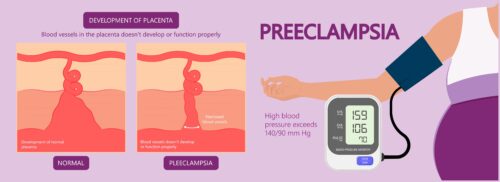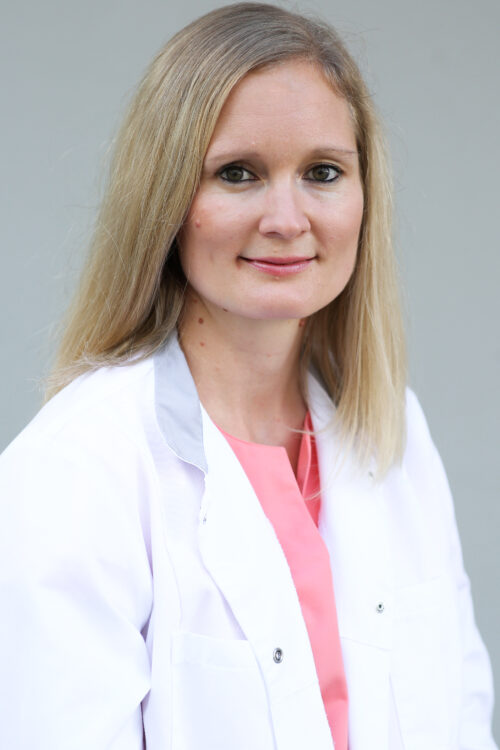Pre-eclampsia screening – detects 75% of cases before 37 weeks of pregnancy.
Pre-eclampsia is when hypertension occurs together with at least one other organ manifestation (usually proteinuria) during pregnancy, usually later in pregnancy. It belongs to the group of hypertensive pregnancy diseases. The signs and symptoms of pre-eclampsia/eclampsia usually disappear quickly after delivery. Pre-eclampsia is a preliminary stage of eclampsia.
Eclampsia is tonic-clonic seizure that occur during pregnancy and cannot be attributed to any other specific cause.

The exact causes of pre-eclampsia have not yet been adequately clarified. It is thought that a problem during the development of the placenta causes the blood vessels to constrict, resulting in high blood pressure. For those who want to know more: insufficient trophoblast invasion with insufficient adaptation of the maternal spiral arteries lay the foundation. As yet largely unknown mediators then lead to a dysfunction of the endothelium (= inner layer of the vessels, capillary leak) and to the full clinical picture of the disease.

Pre-eclampsia (PE) is considered one of the main causes of obstetric complications in mother and child. In the mother, complications occur in numerous organ systems. In particular, it can lead to liver and kidney failure. In addition, there are the long-term consequences of diseases of the cardiovascular system. Women with a history of pre-eclampsia have a 4-fold higher risk of later high blood pressure and a 2-fold higher risk of ischaemic heart disease, stroke or thromboembolism. Eclampsia and especially early pre-eclampsia (before 34 weeks gestation) are also considered to be responsible for about 25% of all neonatal deaths and about 15% of all growth retardations. The incidence of pre-eclampsia varies worldwide between approx. 2-8%. In Switzerland, the incidence of pre-eclampsia is ≤ 2%, i.e. approx. 1800-1900 cases are to be expected per year.

In view of the relatively high and severe maternal and fetal risks of disease, efforts to assess prognosis, early diagnosis and prevention of pre-eclampsia are desirable. In recent years, the question of early detection of pre-eclampsia has increasingly come to the fore. The aim here is to establish screening strategies. If screening shows an increased risk of pre-eclampsia, it is possible to prevent it by taking aspirin.
Acetylsalicylic acid (ASA) leads to an irreversible inhibition of the enzyme cyclooxygenase and thus inhibits prostaglandin and thromboxane formation. Based on these mechanisms, the clumping of the blood platelets is inhibited. In this way, the walls of the placental vessels become less agglutinated, allowing the blood to flow better and more freely. This counteracts high blood pressure in the mother and growth retardation in the child, thus preventing pre-eclampsia. Aspirin is approved by the Food and Drug Administration (FDA) for use in pregnant women. For the prophylaxis of pre-eclampsia, 150 mg of aspirin should be taken daily.
We have the option of screening for the risk of developing pre-eclampsia as part of the first trimester test (ETT). For this purpose, the blood flow in the artery leading to the uterus (uterine artery) is measured by ultrasound according to certain criteria. In addition, blood pressure is measured several times on both upper arms and certain risk factors are asked about. In addition, two specific parameters (PlGF and PAPP-A) are determined in the laboratory. All this information is sent to the laboratory and the risk of pre-eclampsia is calculated according to a certain algorithm.

We recommend screening for pre-eclampsia because of the potentially serious consequences of pre-eclampsia/eclampsia on mother and child described above. The procedure is simple; the measurement of blood flow in the uterine arteries can easily be carried out as part of the first trimester test. This does not significantly increase the duration of the examination and there is no additional charge for the ultrasound examination. The determination of the laboratory parameters is sometimes not covered by the health insurance; the costs are around 80 SFr. The definition of a screening includes the testing of all possible persons of a defined unit, in this case pregnant women in about the 12th to 13th week of pregnancy. This is the only way to reliably determine the number of people at risk.

Specialist for gynecology and obstetrics
Surgical gynaecology i.t.

